SSZT160 may 2021 AWR1843AOP
Millimeter-wave (mmWave) radar is a highly accurate sensing modality for automotive and industrial applications that provides insightful object information such as distance, angle and velocity, enabling smarter sensing solutions that can detect objects at a range of a few centimeters to several hundred meters.
Typically, a radar sensor is assembled on a printed circuit board (PCB) consisting of a radar transceiver, antenna, power-management circuit, memory and interface peripherals. The antennas placed on the PCB require a high-frequency substrate material such as Rogers R03003 – the silver routing material shown in Figure 1.
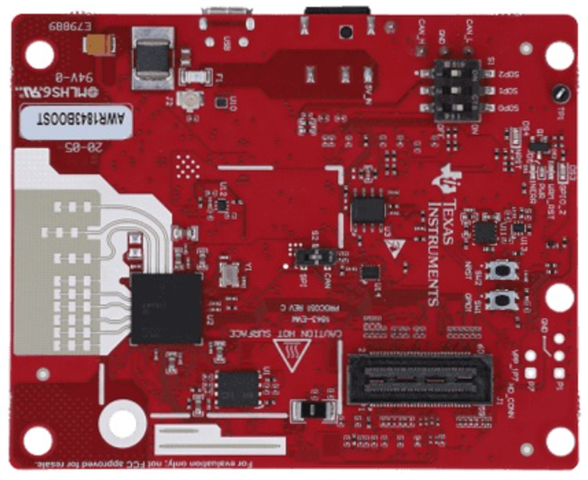 Figure 1 A Radar Sensor with an Antenna
on the PCB
Figure 1 A Radar Sensor with an Antenna
on the PCBAntenna-on-package (AoP) placement eliminates the need for a high-frequency substrate material, reducing cost, manufacturing complexity and approximately 30% of board space. TI AoP technology uses flip-chip package technology to place antennas on a moldless substrate, preventing the antenna from traveling through lossy mold material that could reduce efficiency and cause spurious radiation. Using a multilayer substrate further reduces the board size and enables the antenna and silicon die to overlap more easily.
The AWR1843AOP device directly integrates the antenna onto the package substrate, as shown in Figure 2.
 Figure 2 A TI Radar Sensor with AoP
Technology
Figure 2 A TI Radar Sensor with AoP
TechnologyWith AoP, benefits include:
- An extremely small-sized form factor.
- Lower bill-of-materials costs.
- Lower engineering costs and faster time to market, because there’s no need to design, simulate or characterize antenna performance.
- Reduced power loss by shortening the routing from the silicon die to the antennas.
How AoP Helps in Exterior Near-field Sensing Applications
Car manufacturers are moving toward providing several non-ADAS features to be autonomous, such as automated car door and trunk opening. This feature requires a high-resolution sensor that can detect different types of objects to avoid collisions while opening the door and trunk.
TI’s AWR1843AOP mmWave radar sensor, for near field sensing applications, detects in three dimensions, using a low-powered, single-chip solution integrated with AoP. This highly integrated sensor is small enough to fit into spaces such as door handles, rocker panels and B pillars. Furthermore, AWR1843AOP’s high-range resolution enables it to detect objects regardless of their size, shape or structure.
Detection of Multiple Static Objects
The AWR1843AOP operates in the 76- to 81-GHz bandwidth, which provides a resolution of less than 4 cm. Combining a wide field of view and high range resolution enable detection and distinction between multiple static objects simultaneously. For example, in Figure 3, the AWR1843AOP evaluation kit is mounted on a car door at 43 cm above the ground. The traffic cone, which will create a collision if the door were to open, is marked as the red cube in the graphical user interface. The metal pole, which is further away from the sensor, is marked as green, as it won’t be in the collision zone if the door were to open.
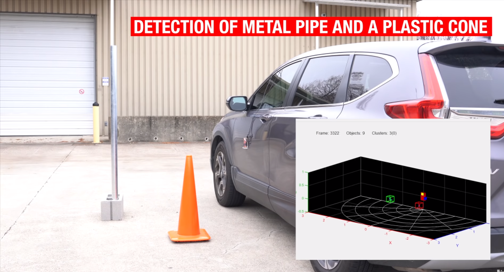 Figure 3 Detection of a Plastic Cone
(Placed inside the Collision Zone) and Metal Pole (Placed outside the Collision
Zone)
Figure 3 Detection of a Plastic Cone
(Placed inside the Collision Zone) and Metal Pole (Placed outside the Collision
Zone)Detection of Low-height Objects
A car door obstacle detection sensor requires a solution that can “see” in three dimensions in order to prevent any collision with objects located below the height of the sensor. Other sensing technologies, like time of flight and ultrasonic, may not detect objects that are located far below or above the height of the sensor. These solutions can be unreliable for detecting low-height objects such as bollards and curbs. A camera-based solution can detect low-height objects but won’t be reliable in challenging weather conditions such as rain or snow. The AWR1843AOP device provides detection in both the azimuth and elevation planes to facilitate the detection of low-height objects. mmWave radar sensors are also resilient in challenging weather conditions. Figure 4 shows the detection of a cinder block acting as a low-height curb using the AWR1843AOP evaluation module (EVM).
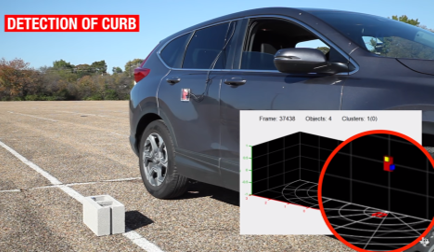 Figure 4 Detection of a Low-height Curb
Using TI’s AWR1843AOP EVM
Figure 4 Detection of a Low-height Curb
Using TI’s AWR1843AOP EVMDetection of Objects with Minimal Surface Area
Objects such as bicycles and grocery carts are difficult to detect because of their shape and structure. The high range resolution and wide field of view enable the AWR1843AOP to detect objects with minimal surface area, as shown in Figure 5.
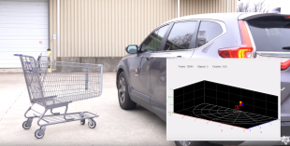
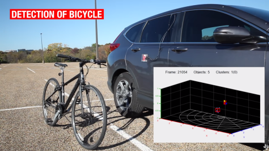
Multimodal Feature
The AWR1843AOP has a multimodal, programmable digital signal processor that allows you to reconfigure the same sensor for multiple applications. For example, you can use an AWR1843AOP device as an obstacle detection sensor (for automated car door opening) as well as a side-view radar sensor (for detecting objects in blind spots when the car is moving). Leveraging this multimodal feature reduces overall system cost, despite the implementation of multiple sensing applications. Figure 6 shows the detection of a cyclist at 5 m using the door obstacle detection sensor.
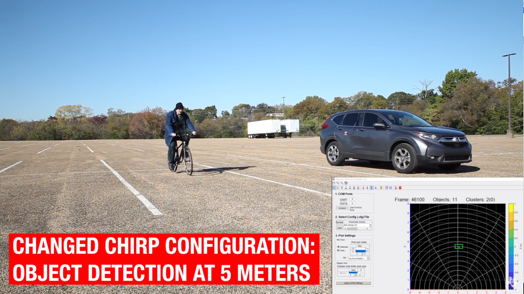 Figure 6 Detection of a Cyclist at 5 M
Using the Door Obstacle Detection Sensor
Figure 6 Detection of a Cyclist at 5 M
Using the Door Obstacle Detection SensorTI AoP technology enables flexible sensor placement in new locations such as door handles. The 77-GHz AWR1843AOP sensor makes it possible to achieve a faster time to market and lower system-level costs for applications such as door obstacle detection, trunk obstacle detection, basic blind-spot detection and park assistance.
Additional Resources
Discover TI near field sensing offering:
Evaluate the sensor performance:
- AWR1843AOP EVM
- Reference software on TI Resource Explorer
- Obstacle Detection
- Obstacle Detection Video
- Ultra-short Range Radar
Design your sensor with confidence: